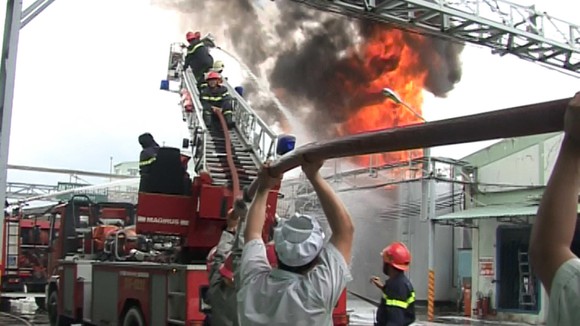Vietnam: What jobs will graduates from intermediate-level firefighting and rescue do?
On December 28, 2018, the Ministry of Labour, Invalids and Social Affairs of Vietnam promulgated Circular 56/2018/TT-BLDTBXH stipulating the minimum knowledge and competency requirements for graduates at intermediate and college levels for disciplines and professions related to transport services, environment, and security.

Vietnam: What jobs will graduates from intermediate-level firefighting and rescue in Vietnam do? (Illustrative Image)
Under Circular 56/2018/TT-BLDTBXH, intermediate-level firefighting and rescue in Vietnam is a discipline or profession that involves jobs such as: Reviewing designs, accepting fire prevention and control tasks; Inspecting fire safety and rescue operations; Propagating and mobilizing the public for fire prevention and rescue; Managing, using, operating, maintaining, and preserving fire prevention and rescue equipment and vehicles; Designing automatic fire alarm and extinguishing systems; Training in fire fighting skills, developing and practicing firefighting plans; Training in rescue skills, developing and practicing rescue plans; Conducting firefighting activities against occurring fires; Organizing rescue activities for incidents and accidents within the scope of the fire fighting and rescue force, meeting level 5 requirements in the Vietnamese Qualifications Framework.
Thus, after completing their studies, graduates from intermediate-level firefighting and rescue in Vietnam perform the following main jobs:
- Preparing basic investigation files; Categorizing facilities under the management of fire prevention and control; Guiding facilities to implement measures ensuring fire safety following regulations; Organizing fire safety inspections at facilities; Handling violations of fire safety regulations;
- Developing programs, plans, and content for fire prevention and rescue propaganda; Organizing fire prevention and rescue propaganda; Guiding the public movement to participate in fire prevention activities at facilities under state management of fire safety and residential areas with high risk of fire and explosion;
- Developing training plans, and training programs, and conducting firefighting and rescue skill training; developing firefighting plans, and rescue plans; Planning and organizing firefighting and rescue plan exercises; Organizing drills for firefighting and rescue plans according to predetermined scenarios;
- Deploying forces, vehicles, and firefighting equipment to promptly extinguish fires; Applying reasonable firefighting tactics and methods to save people, and assets, and prevent fire spread effectively and promptly;
- Organizing the deployment of forces, specialized rescue vehicles, and equipment, and applying appropriate rescue methods and tactics to save people and property at the scene of incidents and accidents achieving the highest effectiveness;
Details can be found in Circular 56/2018/TT-BLDTBXH effective on February 10, 2019.
Ty Na
- Number of deputy directors of departments in Vietnam in accordance with Decree 45/2025/ND-CP
- Cases ineligible for pardon in Vietnam in 2025
- Decree 50/2025 amending Decree 151/2017 on the management of public assets in Vietnam
- Circular 07/2025 amending Circular 02/2022 on the Law on Environmental Protection in Vietnam
- Adjustment to the organizational structure of the Ministry of Health of Vietnam: Certain agencies are no longer listed in the organizational structure
- Vietnam aims to welcome 22-23 million international tourists in Vietnam in 2025
-

- Number of deputy directors of departments in Vietnam ...
- 15:04, 05/03/2025
-

- Cases ineligible for pardon in Vietnam in 2025
- 14:43, 05/03/2025
-

- Decree 50/2025 amending Decree 151/2017 on the ...
- 12:00, 05/03/2025
-

- Circular 07/2025 amending Circular 02/2022 on ...
- 11:30, 05/03/2025
-

- Adjustment to the organizational structure of ...
- 10:34, 05/03/2025
-

- Notable new policies of Vietnam effective as of ...
- 16:26, 11/04/2025
-
.Medium.png)
- Notable documents of Vietnam in the previous week ...
- 16:21, 11/04/2025
-
.Medium.png)
- Notable documents of Vietnam in the previous week ...
- 16:11, 02/04/2025
-
.Medium.png)
- Notable new policies of Vietnam to be effective ...
- 16:04, 02/04/2025
-
.Medium.png)
- Notable new policies of Vietnam effective from ...
- 14:51, 21/03/2025
 Article table of contents
Article table of contents
